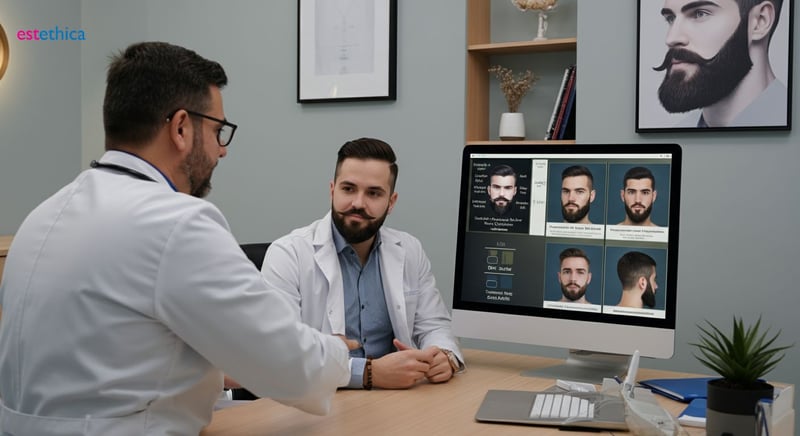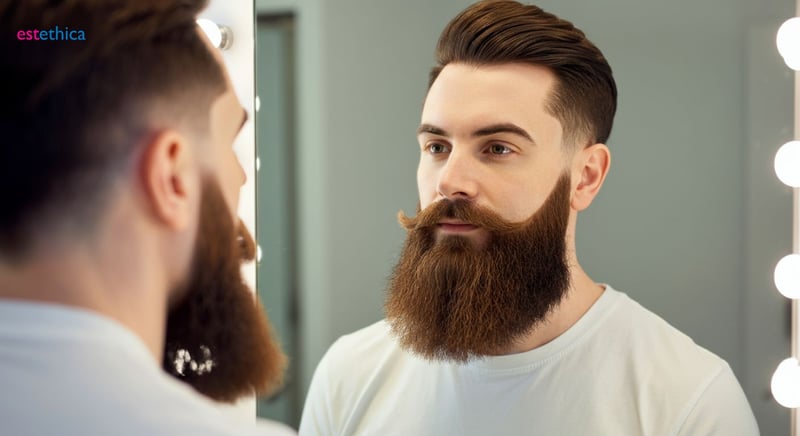Unlock Your Perfect Beard: A Guide to Facial Hair Restoration
Looking to transform your look with a fuller beard? Discover the latest in beard transplant techniques!
Dreaming of a fuller, more defined beard? Facial hair restoration through modern beard transplant techniques might just be the solution for you. In this comprehensive guide, we'll explore the options available for achieving natural-looking results and provide insights on what to expect before, during, and after the procedure. Dive in as we unravel the art and science behind successful beard transplants.
Beard Transplant Techniques: FUE vs. DHI - Which is Right for You?
Key Differences Between FUE and DHI for Beard Transplants
Choosing between Follicular Unit Extraction (FUE) and Direct Hair Implantation (DHI) for a beard transplant involves assessing your specific facial hair restoration goals. FUE stands out as a method where individual follicles are harvested and then implanted, potentially leading to less noticeable scarring. Conversely, DHI employs a specialized tool that implants follicles directly, aiming for enhanced precision and quicker recovery. Both techniques represent advancements in restoring facial hair, but their suitability depends on individual factors such as skin type and desired density. This selection process significantly impacts the outcome of your beard hair transplant, influencing factors like graft survival and the natural look of your beard. Making an informed decision requires understanding these subtle yet important variations.
Advantages of FUE and DHI Techniques
- FUE offers minimal scarring, extracting individual follicles directly from the donor area.
- DHI allows precise placement of hair follicles, enhancing the density and natural appearance of the beard.
- Both techniques result in permanent hair growth, providing long-term solutions for facial hair restoration.
The choice between FUE and DHI techniques also hinges on the expertise of the beard transplant surgeon. The surgeon's skill in either FUE or DHI profoundly affects the success and aesthetic outcome of the procedure.

Achieving Natural-Looking Results: The Art of Beard Hair Transplant Design
The Significance of Personalized Graft Placement in Beard Transplants
Achieving a natural-looking beard through a beard transplant depends heavily on the meticulous placement of each hair follicle. Expert surgeons consider factors like the angle of hair growth and density to mimic natural beard patterns. This careful attention ensures that the transplanted hair blends seamlessly with existing facial hair, avoiding an artificial appearance. Utilizing advanced techniques allows for precise control over the final aesthetic, making each beard transplant unique and tailored to the individual’s facial structure. At Esthetica Global, the focus remains on creating results that not only enhance appearance but also boost confidence through a natural look.
Key Factors for a Natural-Looking Beard Transplant
- Angle of Hair Growth: Surgeons must match the natural angle of existing hair.
- Density Distribution: Appropriate density is key for a balanced, natural appearance.
- Hairline Design: A soft, natural hairline avoids an artificial or harsh look.
The artistry in beard transplant procedures involves more than technical skill; it requires an aesthetic sensibility. Surgeons at Esthetica Global strive to deliver results that align with each patient's vision, ensuring satisfaction and a natural-looking beard.

Beard Transplant: What to Expect Before, During, and After the Procedure?
Navigating the Beard Transplant Journey
Undergoing a beard transplant involves several well-defined phases designed to ensure optimal results. Initially, expect thorough consultations focusing on your desired beard style and assessing your suitability for the procedure. Surgeons meticulously plan the transplant, outlining expected outcomes and detailing the care needed to achieve the best results. During the procedure itself, the emphasis is on utilizing advanced techniques to maximize comfort and precision. Post-operatively, adhering to a detailed care plan is essential for proper healing and ensuring the long-term success of the transplant. Understanding each step not only prepares you for the journey but also aligns expectations with the achievable results at Esthetica Global, where the approach to facial hair restoration balances artistic vision with technical expertise.
Key Stages of a Beard Transplant
- Initial Consultation: Setting realistic expectations and planning the unique design of your new beard.
- Surgical Procedure: Implementing advanced technologies for precision and comfort during the transplant.
- Post-operative Care: Following a specific care routine to aid healing and ensure lasting results from your procedure at Esthetica Global.
Essential Aspects of Beard Transplant Aftercare
- Careful Wound Management: Gentle cleaning is vital to prevent infection.
- Avoiding Strenuous Activities: Limiting physical activity prevents disruption of newly implanted follicles.
- Following Medication Regimen: To minimize inflammation and promote healing, as part of Esthetica Global's focus on holistic care.

Is a Beard Transplant Permanent? Understanding Long-Term Growth and Maintenance
Maximizing the Longevity of Your Beard Transplant
The long-term success of a beard transplant is a primary concern for many considering the procedure. Transplanted hair follicles are designed to last, maintaining their growth characteristics over time, akin to natural hair. Proper maintenance, including regular grooming and trimming, is crucial to keeping the beard looking neat and styled as desired. Following post-operative care instructions diligently significantly contributes to the health and robustness of the transplanted hair, ensuring that your investment yields long-lasting benefits. This comprehensive approach secures the aesthetic and personal satisfaction derived from a well-maintained beard for many years.
Essential Post-Transplant Care Steps
- Gentle Cleaning: Regularly clean the transplanted area as directed by your surgeon at Esthetica Global.
- Moisturization: Keep the skin moisturized to prevent dryness and promote healing.
- Sun Protection: Shield the area from direct sunlight to protect the new hair follicles.
Factors Influencing Beard Transplant Permanence
- Follicle Health: Healthy follicles are more likely to thrive long-term.
- Graft Placement: Proper placement ensures natural growth patterns and density.
- Ongoing Care: Consistent maintenance helps sustain the beard's appearance.
The permanence of your beard transplant is closely linked to the quality of aftercare and the body’s natural healing responses. With appropriate care and maintenance, patients can expect a lasting improvement in their facial hair, enriching their appearance and self-esteem with Esthetica Global’s commitment to excellence.
Precision Beard Restoration via FUE and DHI Techniques
esthetica excels in beard restoration, employing both Follicular Unit Extraction (FUE) and Direct Hair Implantation (DHI) techniques. FUE minimizes scarring with individual follicle extraction, while DHI ensures precise follicle placement for enhanced density.
esthetica's beard transplant surgeons are highly skilled in both FUE and DHI techniques, ensuring successful and aesthetically pleasing outcomes tailored to each patient's unique facial structure and desired beard style. This expertise is crucial in achieving natural-looking results that meet individual expectations.
Comprehensive Care Ensures Successful Beard Transplant Journeys
esthetica provides thorough consultations, meticulous surgical planning, and detailed post-operative care, ensuring each patient is well-prepared and supported throughout their beard transplant journey. Essential post-transplant care includes careful wound management, activity restrictions, and adherence to medication regimens, all contributing to improved healing and lasting results.
Patients at esthetica experience a comprehensive and supportive environment, facilitated by the hospital's patient-focused services and transparent communication. The hospital's mission prioritizes patient safety and health, fostering trust and satisfaction among those seeking facial hair restoration.
Frequently Asked Questions
What are the primary differences between FUE and DHI techniques for a beard transplant?
How can I ensure my beard hair transplant looks natural?
What should I expect during the beard transplant procedure and recovery?
Is a beard transplant permanent, and what maintenance is required?
What factors influence the success and longevity of a beard transplant?
Ready to discover your healthiest, most beautiful self with estethica's personalized aesthetic and healthcare solutions?
📞 Call Now for Your Free Consultation!